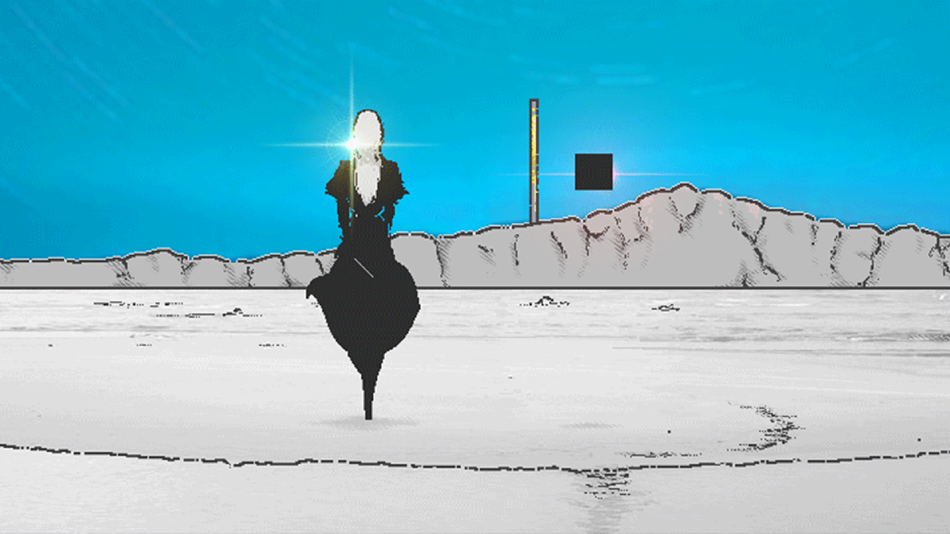AI Will Not Steal Our Joy!

HIGH The art style and comic dialogue in an oppressive setting.
LOW The difference between the two difficulty levels is big.
WTF Every time we save the game, we need to pay?
Artis Impact is set in a post-apocalyptic future, destroyed by artificial intelligence. The land is ravaged, the towns are decadent, populations live isolated, most places are abandoned, and aggressive AI robots roam the map. In this sense, Artis Impact could be just another game about how AI will doom us all, but luckily it decided to be more than that, as this pessimistic setting contrasts with the colorful, cozy aesthetics and the joyful tone of the characters.
This contrast between what we feel as a player and what’s really going on in the world was well-thought-out and executed, becoming the axis of the player experience. While the urban atmosphere is vivid and the interaction with the other human characters is often expressed through humorous dialogue and funny scenes, the outside world, dominated by AI robots, is designed to be intimidating, depressing and dangerous, painted in darker colors. This is the intended message, I believe — that happiness lies only between humans, while AI makes the world sadder.

The world of Artis Impact is cozy. It’s a pixelated project expressed in various 2D ways, but it’s colorful and it feels dynamic. The movements are fluid, the animations are satisfactory to watch, we can interact with almost everything in the world like mailboxes, faucets, and drawers. The transitions between scenes and loading pauses are smooth. The developers clearly paid attention to the details and were able to give warm vibes to this dangerous world — despite the overall destruction and the decayed infrastructure, we often find ourselves in inviting environments like drinking tea in a comfy chair, taking a hot bath, doing part-time jobs, or just doing light-hearted daily activities in Japanese-style streets. Artis Impact is full of situations that will bring a smile to the player’s face despite the larger oppressive framing.
In this dichotomy we play as Akane, a friendly, extroverted, and almost wacky woman – a perfect personality to portray ‘found happiness in a hopeless world.’ For a pixelated 2D character, Akane is full of personality. She works for an organization tasked to combat the AI threat, and she’s always accompanied by a small bot that serves as a guide and as support in combat. Akane’s journey revolves around battling machines, uncovering secrets, discovering treasures, and experiencing bright interactions with the many charismatic characters we meet, while also dealing with philosophical questions found within the cold and depressing world of AI.
It’s inevitable that we make comparisons with things like Nier: Automata. Besides the post-apocalyptic environment and the robotic enemies, Akane holds strong similarities with 2B (the white hair, black clothes, cube-shaped bot companion, an exquisite sword, fighting prowess) and Artis Impact deals with the same core philosophical questions about what it is to be human, contrasting the division of human behavior and AI emulation.

However, unlike Nier: Automata, Artis Impact offers a joyful, whimsical, and colorful mosaic. Akane, unlike 2B, embodies the light of joy in a hopeless world — she saves a bunny, gives coins to a homeless guy, clumsily lights a fireplace with a bomb, or comically reviews the places where she sleeps. Despite the large strokes of both settings appearing the same, the message that the protagonist portraits is different and more optimistic, which is a welcome approach.
The combat in Artis Impact is turn-based. However, instead of being slowly tactical with complex strategies, the turn-based nature of the design feels fluid and moves with a quick pace. The animations are top-notch and the automatic HP restorations, fire support from the bot companion, and counterattack moments are dynamic.
Although this combat is engaging, Artis Impact is fundamentally a narrative-focused experience. While the potential was there to have these sequences drag on by asking the player to little more than press a button and advance dialogue, the story is fulfilling, with peppy punch lines, comedy and drama, in addition to genuinely interesting philosophical questions. What does it mean to be human? What does AI want?

One interesting final detail about Artis Impact is that enemies are represented as shadow-like creatures. We don’t clearly see them, and we might wonder if this is an implicit message from the developers that Akane’s journey is not truly about fighting AI. Indeed, at the end of the adventure, it felt more like a personal journey for Akane, as well as for us. What is our place in an ever-changing world? What do we cherish the most when everything collapses? I won’t spoil the most revealing moments, but Artis Impact is indeed a work that seeks to humanize a world that’s lost everything except its humanity.
Rating: 8 out of 10
Disclosures: This game is developed by Mas and published by Feuxon. It is currently available on PC. This copy of the game was obtained via publisher and reviewed on the PC. Approximately 12 hours of play were devoted to the single-player mode, and the game was completed. There are no multiplayer modes.
Parents: As of press time, this game was not rated by the ESRB. Artis Impact contains strong language that may be offensive to some players and is not suitable for children, primarily adult humor. There are two available modes – the normal mode and the super safe mode. The latter reduces the sensitive content.
Colorblind Modes: There are no colorblind modes available.
Deaf & Hard of Hearing Gamers: This game offers subtitles. (See example above.) The subtitles cannot be altered and/or resized. The only audio this game uses are the soundtrack, the ‘gibberish’ talking noises and some environmental sounds. This game is fully accessible.
Remappable Controls: Yes, this game offers fully remappable controls.

The post Artis Impact Review appeared first on Gamecritics.com.




This post highlights an intriguing perspective on the intersection of art and AI. It’s great to see a focus on how creativity can thrive even in challenging environments. The art style and dialogue sound captivating!